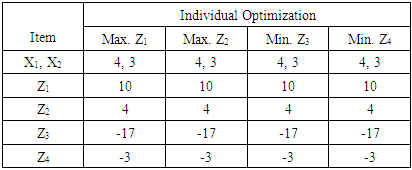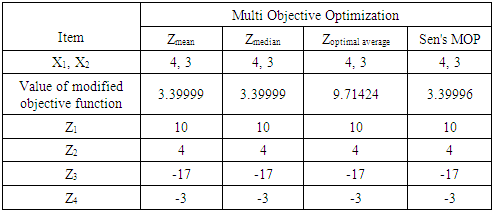-
Paper Information
- Paper Submission
-
Journal Information
- About This Journal
- Editorial Board
- Current Issue
- Archive
- Author Guidelines
- Contact Us
American Journal of Operational Research
p-ISSN: 2324-6537 e-ISSN: 2324-6545
2018; 8(1): 10-13
doi:10.5923/j.ajor.20180801.02

Sen's Multi-Objective Programming Method and Its Comparison with Other Techniques
Chandra Sen
Department of Agricultural Economics, Institute of Agricultural Sciences, Banaras Hindu University, Varanasi, India
Correspondence to: Chandra Sen , Department of Agricultural Economics, Institute of Agricultural Sciences, Banaras Hindu University, Varanasi, India.
| Email: |  |
Copyright © 2018 The Author(s). Published by Scientific & Academic Publishing.
This work is licensed under the Creative Commons Attribution International License (CC BY).
http://creativecommons.org/licenses/by/4.0/

The present paper evaluates the Sen's Multi-Objective Programming (MOP) method for solving multi-objective optimization problems. The method has been successfully used in formulating suitable farm plans for achieving several objectives of maximizing income, maximizing employment, minimizing fertilizer use, minimizing irrigation and plant protection chemicals etc. Few studies have reported several alternative techniques of multi-objective optimization and concluded their superiority over Sen's MOP method with illogical interpretations. The examples used to demonstrate the solutions of these MOP techniques were also not appropriate.
Keywords: Linear Programming, MOP, Mean, Median and Optimal average techniques
Cite this paper: Chandra Sen , Sen's Multi-Objective Programming Method and Its Comparison with Other Techniques, American Journal of Operational Research, Vol. 8 No. 1, 2018, pp. 10-13. doi: 10.5923/j.ajor.20180801.02.
Article Outline
1. Introduction
- Linear programming has been extensively used to optimize (maximize or minimize) single objective function subject to certain constraints. It is a little difficult to optimize two or more objectives at a time and becomes more difficult if the objectives are conflicting in nature. It was realized to explore the possibilities of generating the compromising solution that achieves all the objectives simultaneously. Several methods have been developed for solving multi-objective optimization problems. In the constraint method, the most preferred objective is optimized keeping other objectives as constraints. The weighted sum method scalarizes the set of objective functions into the single objective function. Most of the new methods are weighted sum methods proposed during past decade. These methods have been evaluated with respect to the formulation of multi-objective function, suitability of the numerical examples solved and the interpretations of the solution.
2. Multi-Objective Programming Methods
2.1. Sen's Multi-Objective Programming Method
- Sen [1] proposed a method of Multi-Objective Programming for achieving several conflicting objectives simultaneously. A Multi-Objective Function is formulated and optimized under common constraints. The mathematical form of MOP is described as:Optimize Z= [Max. Z1, Max. Z2 ......Max. Zr Min. Z r+1.......Min. Zs]Subject to:AX = b and X≥ 0The individual optima are obtained for each objective separately as:Zoptima = [W1, W2..........Ws]The Multi-Objective Function is formulated as:Maximize,
 Subject to:AX = b and X≥ 0Wj ≠ 0 for J=1, 2..........s.Wj= Optimum value of jth objective functionThe combined objective function was formulated by weighting each objective function by inverse of its optima which make the objective function dimension free. Therefore the combined objective function is constructed without any problem with the objective functions of different dimensions. The method has been successfully used by many research scholars/ scientists [3-11, 13] to formulate an alternative cropping plan for the farmers for achieving two to six objectives simultaneously. The objectives were the maximization of income and employment and minimization of fertilizer use, irrigation water, CO2 emissions, Plant protection chemicals, etc. The results of all the studies were satisfactory.
Subject to:AX = b and X≥ 0Wj ≠ 0 for J=1, 2..........s.Wj= Optimum value of jth objective functionThe combined objective function was formulated by weighting each objective function by inverse of its optima which make the objective function dimension free. Therefore the combined objective function is constructed without any problem with the objective functions of different dimensions. The method has been successfully used by many research scholars/ scientists [3-11, 13] to formulate an alternative cropping plan for the farmers for achieving two to six objectives simultaneously. The objectives were the maximization of income and employment and minimization of fertilizer use, irrigation water, CO2 emissions, Plant protection chemicals, etc. The results of all the studies were satisfactory.2.2. Alternative Weighted Sum Methods
- The alternative methods have been suggested by the scientists [13-20] to solve the multi-objective optimization problems. The Multi-Objective Function was formulated using mean, median, average mean/ median, new average mean/ median, arithmetic average and new arithmetic average techniques.
2.3. Formulation of Multi-Objective Function
- Optimize Z= [Max. Z1, Max. Z2 ......Max. Zr Min. Z r+1.......Min. Zs]Subject to:AX = b and X≥ 0All the objectives are optimized individually. The mean, median and optimal averages of optimal values for maximization and minimization objectives are estimated separately [13]. When the objective functions are of different dimensions, the estimation of mean, median of optimal average is not logical. The combined objective function is constructed by weighting the objective functions by the inverse of the mean median and optimal average as given below:
 When the objective functions are of different dimensions, the estimation of mean, median of optimal average is not logical. These techniques have been explained with the following example and compared with Sen's MOP method.
When the objective functions are of different dimensions, the estimation of mean, median of optimal average is not logical. These techniques have been explained with the following example and compared with Sen's MOP method. 3. Solving MOP Problem
- The numerical example used in the studies [13,17] has been reproduced below:Example 1:Max. Z1 = X1 + 2X2Max. Z2 = X1Min. Z3 = -2X1 -3X2Min. Z4= - X2Subject to:6X1 + 8X2 ≤ 48X1 + X2 ≥ 3X1 ≤ 4X2 ≤ 3X1, X2 ≥ 0The solution of individual optimization of the problem is given in the table 1.
|
|
4. Appropriate Example for Using MOP Methods
- A suitable cropping plan for a farmer having 7 acres of land was prepared. The crops are X1, X2, X3, X4 and X5. The objectives for farm planning are maximization of farm income, maximization of employment on farm, minimization of plant protection chemicals and minimization of fertilizer use. The minimum area for certain crops has been restricted for home requirements. The multi-objective programming problem can be formulated as detailed below:Example 2:Max. Z1= 7000X1 + 10000X2 + 4000X3 + 5000X4 + 9000X5Max. Z2= 89X1 + 50X2 + 100X3 + 79X4 + 95X5Min. Z3 = 10X1 + 15X2 + 14X3 + 13X4 + 12X5Min. Z4 = 150X1 + 120X2 + 140X3 + 100X4 + 130X5Subject to:X1 + X2 + X3 + X4 + X5 = 7 (Land restriction)X1 ≥ 0.7 (Home requirement)X2 ≥ 0.3 (Home requirement)X3 ≥ 0.4 (Home requirement)X5 ≥ 0.6 (Home requirement)Where Z1= Income (Rs.), Z2= Employment (Man days), Z3= Plant Protection Chemicals (Liter) and Z4= Fertilizer use (Kg.)
5. Optimal Cropping Plan
5.1. Individual Optimization
- The solution of the individual optimization is presented in Table 3. The results reveal that in maximization of income, the level of income achieved is highest but the other objectives have not been achieved to the desired extent.
|
5.2. Multi-objective Optimization
- The problem was solved using mean, median, optimal average and Sen's MOP method and the results have been presented in the Table 4. The solution of mean, median and optimal average are all the same and perfectly matching with the solution of the income maximization. This is due to the dominance of the values of the income over the values of employment, plant protection chemicals and the fertilizer use. The deviations in values of multi-objective functions depend on the method of formulation of the multi-objective function. However, the Sen's MOP method has generated the compromising solution. The values of all the objective functions are not equal to their respective individual optima, but closer to these values. The value of multi-objective function is highest in the optimal average method followed by Sen’s MOP method with lowest values in mean and median methods. The values of multi-objective function should not be considered for the evaluation of these methods. The results indicate that Sen's MOP method is simple and efficient for solving multi-objective programming problems.
|
6. Conclusions
- Sen's MOP method explores the compromising solution for conflicting objectives. The alternative MOP methods reported in certain studies have not been formulated appropriately and their solutions have also not been interpreted correctly. The applications of these techniques have been demonstrated with inferior examples.
 Abstract
Abstract Reference
Reference Full-Text PDF
Full-Text PDF Full-text HTML
Full-text HTML


